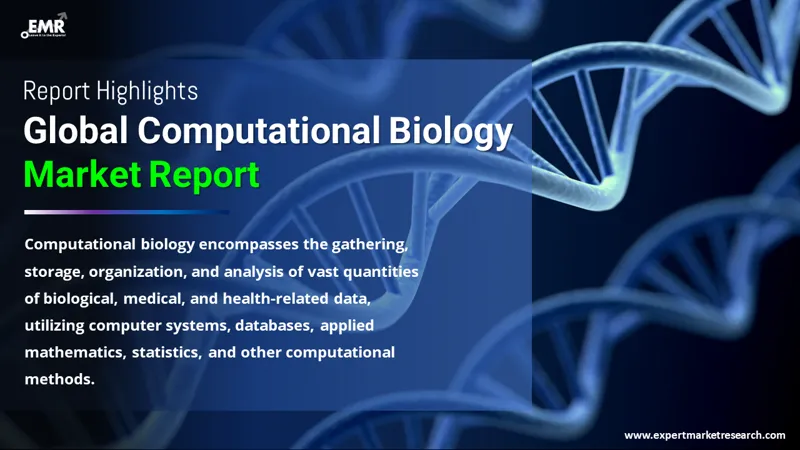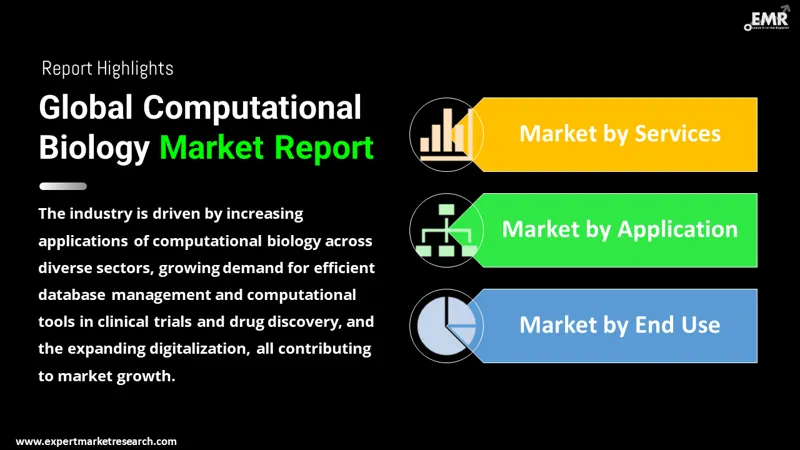
Consumer Insights
Uncover trends and behaviors shaping consumer choices today
Procurement Insights
Optimize your sourcing strategy with key market data
Industry Stats
Stay ahead with the latest trends and market analysis.
The global computational biology market was valued at USD 6.43 Billion in 2025 driven by increasing investments in computational biology research and the rising interdisciplinary collaborations across the globe. The market is further expected to grow at a CAGR of 22.50% in the forecast period of 2026-2035 to attain a value of over USD 48.93 Billion by 2035.
Base Year
Historical Period
Forecast Period
The rising regulatory support towards the integration of advanced computational methods in drug safety and efficacy evaluations is expected to drive market demand in the forecast period.
The increasing adoption of high-performance computing (HPC) and cloud computing in computational biology is poised to drive innovation and growth in the market.
The market share is influenced by the increased strategic collaborations, substantial investments, and advancements in bioinformatics tools.
Compound Annual Growth Rate
22.5%
Value in USD Billion
2026-2035
*this image is indicative*
Computational biology is defined as a field of science that involves the collection, storage, organization, and analysis of a large amount of biological, medical, and health-related data with the help of computers, databases, applied mathematics, statistics, and others. It involves the development and application of mathematical modelling, computational simulation techniques, and data-analytical methods to study biological systems.
The global computational biology market is driven by its growing demand in various end-use sectors, including academics and research studies. The computational approaches help enhance the management of a large volume of data during clinical trials and allow for the efficient utilization of biological data to develop algorithms. The rapid development of molecular biology and genetic engineering tools has been contributing to the market growth significantly. The growing application of computational biology in various commercial and third-party services for carrying out drug discovery processes is likely to boost the market share in the forecast period. Other factors that influence the market growth include advancements in bioinformatics tools, innovations in cloud computing, and increased grants and funding programs to support computational biology research.

Read more about this report - REQUEST FREE SAMPLE COPY IN PDF
Regulatory Support for Advanced Computational Methods to Affect the Market Landscape Significantly
In August 2023, biosimulation company Certara’s division Simcyp Group received two new grants from the United States Food and Drug Administration (FDA) with the aim of expanding its innovative predictive models for drug virtual bioequivalence (VBE) studies and creating a formulation toolbox for topically applied drugs. This collaboration with the FDA will facilitate the development of model-informed approaches and is likely to ensure faster and more cost-effective development of novel drugs as well as complex generics. The rising regulatory support towards the integration of advanced computational methods in drug safety and efficacy evaluations is anticipated to bolster market growth in the coming years.
Increased Investment to Meet Rising Computational Biology Market Demand
There is a growing recognition of the importance and potential of computational biology, which is attracting significant investments from institutional investors, private donors, and venture capitalists. For instance, in November 2023, Carnegie Mellon University's Computational Biology Department received an investment of USD 25 million from the university's trustees. The funding was intended to be used in establishing an endowment, supporting the program's strategic priorities and infrastructure development. Such financial backing in the field of computational biology is poised to promote innovation and the development of new technologies, which will ultimately impact market growth.

Read more about this report - REQUEST FREE SAMPLE COPY IN PDF
The market is witnessing several trends and developments to improve the current global scenario. Some of the notable trends are as follows:
Market Breakup by Services
Market Breakup by Application
Market Breakup by End User
Market Breakup by Region
Market Segmentation Based on Application Areas is Anticipated to Witness Substantial Growth
The market breakup by application includes genomics and genetics, and drug discovery and development, among others. The genomics and genetics segment employs computational biology in the analysis and interpretation of genetic and genomic data. Computational tools are increasingly utilized in genome sequencing and analysis, genetic variation and mutation analysis, comparative genomics, and others. This segment benefits significantly by leveraging advanced computational biology techniques in research studies for facilitating an enhanced understanding of genetic disorders and the development of genetic tests. The drug discovery and development segment is also poised to witness substantial growth, owing to the growing demand for computer simulations in drug design, virtual screening to identify potential drug candidates, and the process of discovering new drugs and therapies.
Based on the region, the market covers North America, Europe, Asia Pacific, Latin America, and the Middle East and Africa. In North America, the market holds a considerable share and is driven by the growing investments directed at the development of efficient design and modeling-related computational tools to assess the complexity of biological systems. Over the forecast period, the rising government funding towards academic and biological research studies in countries like the United States and Canada is likely to propel the market growth. The market will further be aided by the rising penetration of advanced digital solutions and high-performance computation tools, coupled with the increasing research and development across the region.
The key features of the market report comprise funding and investment analysis and strategic initiatives by the key players. The major companies in the market are as follows:
The software company based in Canada, is a key player in the market and is known for its drug discovery software platform MOE (Molecular Operating Environment) which integrates modeling and simulations, visualization, and methodology development.
This French multinational software corporation, specializing in the development of software for 3D product design and simulation, is a prominent player in the market. One of its popular products is the BIOVIA Pipeline Pilot which allows researchers to automate complex data analysis processes.
Certara offers a wide range of services in model-based drug development, regulatory science, and clinical pharmacology and significantly contributes to the computational biology market growth. It boasts a robust portfolio including leading PK/PD modeling and simulation software Phoenix®.
Instem plc, a global provider of software solutions and services, offers a broad range of solutions supporting both preclinical and clinical research. The company is known for its ALPHADAS software solution, a clinical trial management system (CTMS) designed for early-phase clinical trials.
*Please note that this is only a partial list; the complete list of key players is available in the full report. Additionally, the list of key players can be customized to better suit your needs.*
Other key players in the market include Compugen, Genedata, YOKOGAWA DENKI KABUSHIKI KAISHA, STRAND LIFE SCIENCES PRIVATE LIMITED, Schrödinger, Inc., and SimulationPlus.




*While we strive to always give you current and accurate information, the numbers depicted on the website are indicative and may differ from the actual numbers in the main report. At Expert Market Research, we aim to bring you the latest insights and trends in the market. Using our analyses and forecasts, stakeholders can understand the market dynamics, navigate challenges, and capitalize on opportunities to make data-driven strategic decisions.*
Get in touch with us for a customized solution tailored to your unique requirements and save upto 35%!
Explore our key highlights of the report and gain a concise overview of key findings, trends, and actionable insights that will empower your strategic decisions.
| REPORT FEATURES | DETAILS |
| Base Year | 2025 |
| Historical Period | 2019-2025 |
| Forecast Period | 2026-2035 |
| Scope of the Report |
Historical and Forecast Trends, Industry Drivers and Constraints, Historical and Forecast Market Analysis by Segment:
|
| Breakup by Services |
|
| Breakup by Application |
|
| Breakup by End User |
|
| Breakup by Region |
|
| Market Dynamics |
|
| Supplier Landscape |
|
| Companies Covered |
|
Single User License
One User
USD 5,499
USD 4,949
tax inclusive*
Datasheet
One User
USD 3,299
USD 2,969
tax inclusive*
Five User License
Five User
USD 6,999
USD 5,949
tax inclusive*
Corporate License
Unlimited Users
USD 8,199
USD 6,969
tax inclusive*
*Please note that the prices mentioned below are starting prices for each bundle type. Kindly contact our team for further details.*
Flash Bundle
Small Business Bundle
Growth Bundle
Enterprise Bundle
*Please note that the prices mentioned below are starting prices for each bundle type. Kindly contact our team for further details.*
Flash Bundle
Number of Reports: 3
20%
tax inclusive*
Small Business Bundle
Number of Reports: 5
25%
tax inclusive*
Growth Bundle
Number of Reports: 8
30%
tax inclusive*
Enterprise Bundle
Number of Reports: 10
35%
tax inclusive*
How To Order

Select License Type
Choose the right license for your needs and access rights.

Click on ‘Buy Now’
Add the report to your cart with one click and proceed to register.

Select Mode of Payment
Choose a payment option for a secure checkout. You will be redirected accordingly.
Gain insights to stay ahead and seize opportunities.

Get insights & trends for a competitive edge.

Track prices with detailed trend reports.

Analyse trade data for supply chain insights.

Leverage cost reports for smart savings

Enhance supply chain with partnerships.

Connect For More Information
Our expert team of analysts will offer full support and resolve any queries regarding the report, before and after the purchase.
Our expert team of analysts will offer full support and resolve any queries regarding the report, before and after the purchase.
We employ meticulous research methods, blending advanced analytics and expert insights to deliver accurate, actionable industry intelligence, staying ahead of competitors.
Our skilled analysts offer unparalleled competitive advantage with detailed insights on current and emerging markets, ensuring your strategic edge.
We offer an in-depth yet simplified presentation of industry insights and analysis to meet your specific requirements effectively.
Share